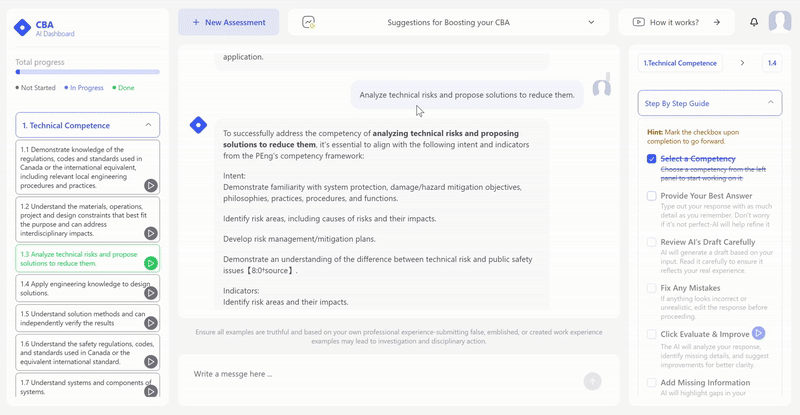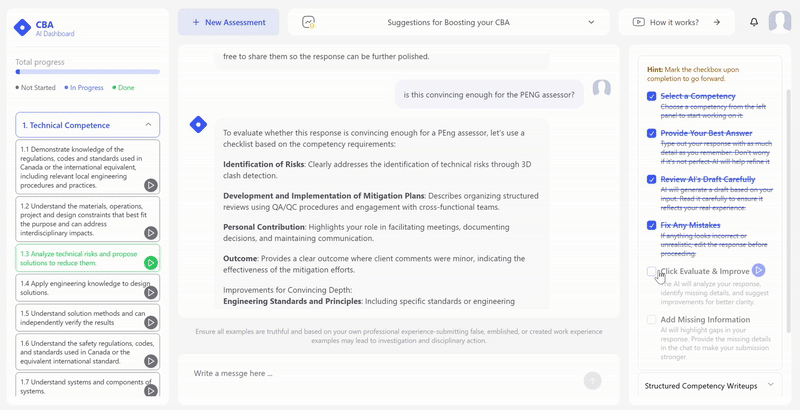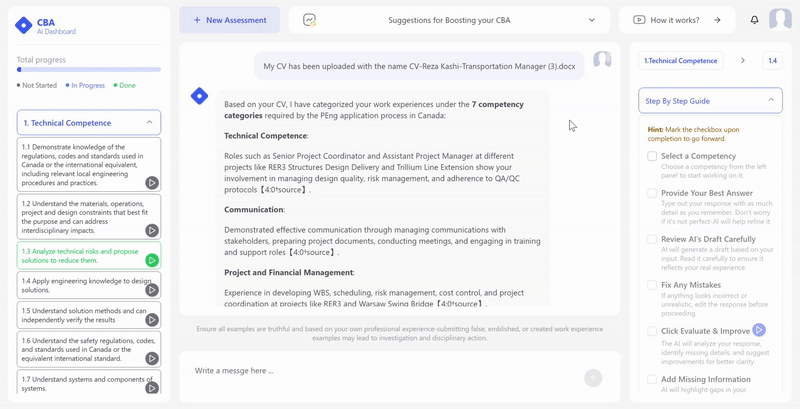Introduction
For engineers pursuing their P.Eng. licensure in Canada, writing the Competency-Based Assessment (CBA) is a pivotal milestone. It’s your opportunity to showcase not just your work history, but your ability to think critically, apply engineering principles, and uphold professional standards in real-world settings. Unfortunately, many applicants stumble, not because they lack the experience, but because they misrepresent it in their submissions.
CBA writing is more than filling out a form or recounting project duties. Each example must clearly demonstrate how you meet a specific competency, using structured narratives that highlight your individual contributions and engineering judgment. Even strong candidates can falter by using vague language, failing to address the right indicators, or underestimating the importance of their validators.
In this blog, we’ll break down the most common mistakes in CBA submissions—from misusing work examples to misaligning content with competency expectations. You’ll also learn how CertNova’s CBA Pro tool helps you avoid these pitfalls by guiding you through tailored prompts, real-time feedback, and competency alignment checks. Whether you’re drafting your first submission or revising for resubmission, this guide will give you the clarity you need to succeed.
Mistake #1 – Writing Tasks Instead of Demonstrating Competence
One of the most common mistakes in CBA writing is confusing job responsibilities with competency demonstrations. Many applicants fall into the habit of listing tasks, what they were assigned or what the team accomplished, rather than showcasing how they applied engineering judgment and solved problems. While it’s important to set the context, assessors are evaluating your individual competence, not your job description.
For example, writing “I was responsible for reviewing designs” tells us what your duty was, but it doesn’t demonstrate your thought process, actions, or outcomes. A stronger approach would be: “I independently reviewed HVAC system drawings to identify code compliance issues and proposed design modifications to reduce pressure losses by 18%.” This clearly demonstrates initiative, technical knowledge, and a measurable impact—exactly what assessors are looking for.
To avoid this mistake, structure your example using the STAR method:
-
Situation – What was the context or problem?
-
Task – What was your specific role or objective?
-
Action – What steps did you take to resolve the issue?
-
Result – What was the outcome of your action? Can it be quantified?
Using STAR helps you move from “what I did” to “how I did it and why it mattered.” Even for collaborative work, focus on your unique contributions and the decisions you made. CBA Pro reinforces this structure through built-in guidelines and tailored interview style Q&A that ensure every example captures the full depth of your competency—no guesswork, no fluff.

PEO CBA Guide Reference: https://www.peo.on.ca/apply/pre-may-15-applicants/application-process
Mistake #2 – Using Vague or Generic Language
Another frequent mistake in CBA submissions is relying on vague, generic language that fails to convey real engineering insight. Phrases like “I was involved in…”, “I participated in…”, or “I supported…” are red flags for assessors. They raise questions: What exactly did you do? Were you leading, assisting, observing? Generic phrases obscure your role and fail to demonstrate the depth of your technical and professional competencies.
Let’s look at a weak example:
“I participated in the preparation of technical drawings.”
Now compare it to a stronger version:
“I prepared detailed civil site drawings using AutoCAD, incorporating municipal standards and coordinating with the electrical and mechanical teams to resolve spatial conflicts.”
The second version clearly shows ownership, tools used, standards applied, and cross-disciplinary collaboration—key elements that bring the example to life and meet the CBA expectations.
Here’s how to strengthen your language:
-
Use active voice: “I led,” “I analyzed,” “I validated.”
-
Be specific: Mention tools, standards, quantities, outcomes.
-
Quantify results: If possible, include metrics (e.g., cost savings, time reductions, error rates).
-
Avoid filler: Skip fluffy words like “various,” “several,” or “a number of”—get straight to the point.
Here is PEO CBA Guide for your reference: https://www.peo.on.ca/sites/default/files/2024-01/CBA-Guide.pdf
CBA Pro’s smart writing assistant helps eliminate vague wording by flagging generic phrases and prompting for clarity. Its built-in suggestion engine offers targeted improvements so you can revise in real time—helping your examples stand out with confidence.

Mistake #3 – Reusing One Work Example Without Customizing for Each Competency
It’s perfectly acceptable—and even encouraged—to use the same work experience across multiple competencies, as long as it reflects different aspects of your engineering practice. The mistake many applicants make is copy-pasting the same example into multiple competency fields without adjusting the focus. This results in vague, redundant submissions that fail to meet the specific intent of each competency.
Let’s say you use an infrastructure project where you served as a lead engineer. You might use this project to demonstrate:
-
Technical competence by highlighting design calculations and regulatory compliance,
-
Project management by describing how you handled timelines and budgets,
-
Communication by explaining how you coordinated with contractors and municipal stakeholders.
However, if you use the same paragraph for all three without tailoring it, assessors won’t be able to evaluate the distinct skills required for each competency. Each entry must be laser-focused on the competency being assessed, aligning with the indicators outlined in the official CBA guide.
Here’s how to do it right:
-
Retell the same situation with a new lens for each competency.
-
Align the language and outcomes to what the competency measures.
-
Use the STAR method every time, even if the situation is the same.
CBA Pro makes this process easier by allowing you to duplicate work examples across competencies—but it prompts you to customize each version based on the competency you’re addressing. This ensures your examples stay efficient, targeted, and impactful.

Mistake #4 – Not Aligning with the Indicators in the PEO Guide
Each of the 22-34 competencies outlined by the engineer associations in Canada includes specific indicators—examples of actions, knowledge areas, and behaviors that demonstrate proficiency. One of the most overlooked steps in CBA writing is failing to align your work examples with these indicators. Applicants often write solid examples, but if they don’t speak directly to what assessors are looking for, their efforts may fall flat.
Each competency isn’t just a label—it comes with context. For example, Competency 1.1 (Knowledge of regulations, codes, and standards) includes indicators like identifying legal requirements, designing for code compliance, and recognizing Indigenous regulations. If you write about preparing a report without referencing any of these elements, assessors may conclude that you haven’t demonstrated the competency—even if your work was otherwise relevant.
To avoid this:
-
Review the indicators in the CBA guide before writing each example.
-
Underline or highlight key actions you need to address.
-
Explicitly mention how your experience aligns with one or more indicators.
-
Use the same language where appropriate—this makes it easier for assessors to map your work to the competency.
CBA Pro integrates the full competency guide, giving you direct access to each indicator as you write. It also offers side-by-side views so you can ensure that your examples are aligned—not just in spirit, but in structure and terminology.

Mistake #5 – Weak or Incomplete Validator Support
Even a perfectly written CBA can fall short if your validator feedback doesn’t support your claims. Validators play a crucial role in the Competency-Based Assessment process. Their job is to independently confirm your experience, rate your performance using the same scale as the assessors, and provide brief comments to back their ratings. When validators aren’t familiar with your work, aren’t aligned with your examples, or submit vague feedback—or worse, don’t respond at all—your submission is at risk.
Common validator-related issues include:
-
Choosing the wrong validator: Someone too far removed from the work example, or not technically qualified.
-
Disagreements in ratings: When your self-rating says “4” but your validator gives a “2” with no explanation.
-
Minimal or no comments: Leaving assessors without the evidence they need to verify your claim.
To avoid this mistake:
-
Choose validators who had direct supervisory or technical oversight of the work.
-
Brief them ahead of time—share your draft examples and explain how their input affects the outcome.
-
Make sure they understand the rating system and expectations of their role, as outlined by your association.
-
Follow up to ensure their submission is completed before the deadline.
Conclusion: Clarity, Consistency, and Competence Matter
Writing a compelling CBA submission isn’t about impressing assessors with fancy language or massive projects—it’s about demonstrating that you can apply engineering principles responsibly, consistently, and effectively. By avoiding these five common mistakes—writing task-based narratives, using vague language, failing to tailor examples, ignoring key indicators, and neglecting validator coordination—you greatly increase your chances of success.
Remember, the CBA is your professional story. It should reflect not just what you’ve done, but how you’ve grown, how you’ve solved problems, and how you’re ready to take on the responsibilities of a licensed professional engineer in Canada. Assessors aren’t looking for perfection—they’re looking for clarity, consistency, and competence.
🔧 Tools like CBA Pro are designed to simplify this process. From guiding your writing structure to aligning your examples with competencies, CBA Pro ensures that you stay focused, accurate, and confident. Don’t let preventable mistakes slow down your licensure journey—let technology work for you.
Ready to strengthen your CBA submission and get closer to your P.Eng license?
Let CBA Pro guide your experience documentation with precision and confidence.
Click here, and start your journey with a personalized intake today!
Helpful Sources:
From the PEO CBA Guide (2023) and provincial regulator websites:


